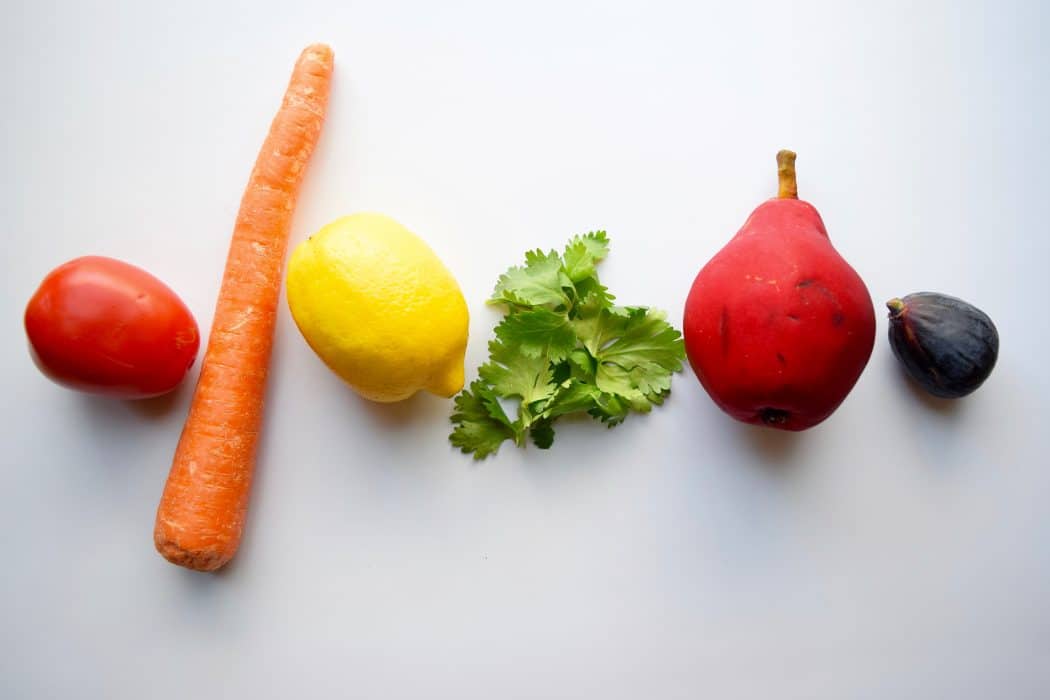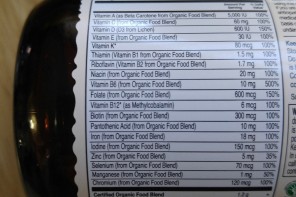And here we have the fifth installment of “The Ultimate Cooking Guide” series! You can read the previous ones here: Terms, Tools, Grains and Starches, Legumes
There’s a lot more to fruits and vegetables beyond personal preferences and what’s on sale. There’s what’s in season to begin with, how to prepare it for ultimate flavor, and how to balance out those flavors.
Cooking Method
Boil/Blanch
When cooking produce, you should only boil it for extended amounts of time if you are making a soup. Boiling pulls nutrients out of the fruit/vegetable and into the liquid. Blanching is a healthier alternative because it is done quickly to avoid the draining of nutrition. To blanch, bring a pot of salted water to a boil. Then add vegetables (be careful not to overcrowd). Boil for several minutes and then remove and place vegetables in ice water to stop the cooking process. Let drain before serving. Vegetables are typically blanched/boiled, although some fruit (like pears) are poached in a flavored liquid. Firm veggies like broccoli, green beans, cauliflower, asparagus, or carrots work well in this method.
Dry
Drying fruits and vegetables concentrates their flavor and nutrients by removing the water. It’s excellent when used on fruit to create a sweet treat but it’s also a great way to enjoy vegetables as a salty snack. Drying preserves produce so it can be enjoyed for longer. To dry a fruit or vegetable, just preheat your oven to around 140 degrees F and, if you can safely do so, crack the door open by an inch or two. Otherwise, a convection oven works too. Put the fruit or vegetables on a baking sheet (sliced, whole, cubed, etc.) and cook until the moisture has evaporated and the produce is dry.
Fry
Who doesn’t love some friend potatoes? Frying vegetables isn’t exactly the healthiest way to eat them, but it’s pretty darn good as a treat. Any vegetable can be fried for a savory addition to a meal. Fried fruit, particularly banana, can be an interesting and delicious part of a dessert. Fried bananas on ice cream is absolute heaven. To fry, whip up a batter or dredging station. Heat a pot of oil over medium-high heat. Dip the produce into the batter and drop into the oil. Cook for a few minutes, until the food is golden brown. Let drain on a paper towel and cool before serving.
Grill
Grilling is perhaps the most pure way to cook. There’s just fire and food. Depending on what the heat source is, grilling can add new and rich flavors into produce, like smokiness or char. Larger vegetables can be grilled right on the rack, but smaller ones need to be skewered or placed on something with smaller slits so they don’t fall through. Grilled vegetables are great served simply on top of a grain or with a starch. Grilled fruit is surprising in that it adds lovely savory flavors to otherwise very sweet desserts, balancing a dish out.
Raw
Sometimes a fruit or vegetable is just better raw, both nutritionally and taste-wise. For example, vitamin c is a heat sensitive nutrient, so dark green vegetables should not be overcooked if they aren’t eaten raw. On the other hand, cooking a vegetable like carrots means that there is more beta carotin available for our bodies. Then there’s fruit, which most of the time is better fresh in it’s whole state. The point is that fruits and vegetables should be eaten sometimes raw and sometimes cooked to get more nutrition.
Roast
Roasting is my favorite method of cooking because it deepens flavors and brings out natural sweetness. Roasting cooks food with dry, hot air to create an even bake. Sweeter vegetables like beets and squash do really well with roasting because it makes them even more naturally sweet. Roasting fruit, like figs, is also a great way to bring out sweetness. To roast, simply put your favorite produce in an oven with seasoning and a bit of oil and bake until golden or soft.
Saute
Sauteing produce is a very easy way to cook it while keeping most of it’s original texture and flavor. While flavors are enhanced with cooking and heat, sauteing helps vegetables stay truer to their natural state. As for fruits, sauteing can make a fruit slightly sweeter and softer without turning it into mush. To saute, heat a little oil or fat in a saute pan over high heat. Add the ingredient and cook briefly until desired consistency and doneness is achieved.
Steam
Steaming is a cooking method that is often used when the nutrients of an ingredient are wished to stay more intact. Because boiling drains nutrients out of a vegetable, steaming a great alternative. But steaming doesn’t have to be bland and boring. With the right seasoning, a steamed vegetable can be delicious. It also helps the vegetable taste the closest to raw while still being cooked, so if the goal is to highlight the natural flavor of an ingredient, this is the method. Fruit isn’t typically steamed unless you’re making baby food, but give it a try! To steam, use a basket or double boiler. Heat a little water on the bottom until it’s simmering and cook produce covered until soft.
Flavor
When it comes to cooking, the right flavor pairing can take a dish from tasty to delicious. It depends on what your goal is for the recipe, but different flavor profiles can help to emphasize something like sweetness or balance out bitterness or create “umami”. I included a flavor not typically seen in traditional flavor profiles because I felt like it was an important one for a post about produce: earthiness.
Bitter:
Fruit: Grapefruit, bitter melon, bitter orange, olives, crabapples
Vegetables: Radicchio, endives, brussels sprouts, escarole, spinach, dandelion greens, frisee, kale, okra, chicory, eggplant, rapini/broccoli rabe
Bitterness balances out/is balanced by sweetness and salt.
Earthy:
Vegetables: Beets, cabbage, broccoli, mushrooms, swiss chard, kohlrabi, rutabagas, collard greens, zucchini, yellow squash
Earthiness is not a typical “flavor profile” selection, but it’s included because it’s a nice, neutral flavor and can be enhanced with bitterness, sweetness, tartness, spiciness, or umami.
Spicy
Vegetables: Radishes, turnips, onions, ginger, chile peppers, leeks, arugula, garlic, watercress, basil
Spiciness balances out/is balanced by sour and sweet.
Sweet
Fruit: Watermelon, figs, dates, peaches, melons, grapes, mangoes, nectarines, clementines, tangerines, bananas, plums, pears, pluots, fuji apples, gala apples, red and golden delicious apples, honeycrisp apples, pomegranate, etc. (most fruit)
Vegetables: Sweet potatoes, yams, corn, bell pepper, beets, parsnips, butternut squash, acorn squash, spaghetti squash, delicata squash, fennel, carrots, sugar snap peas
Sweetness balances out/is balanced by bitterness, sourness, and spiciness.
Tart/Sour
Fruit: Blueberries, lemon, raspberries, grapes, cherries, lime, pineapple, kiwis, granny smith apples, braeburn apples, papayas, strawberries, apricots
Vegetables: Lemongrass, tomatillos, sorrel, tomatoes
Tartness balances out/is balanced by sweetness and spiciness.
Umami
Vegetables: Tomato, mushrooms
Umami is basically a “pleasant savory taste” and is the end goal of most dishes. Umami balances out bitterness and can enhance sweetness.
Season
Thanks to the large, chain grocery stores, most produce can be found year-round. But when you get something like strawberries in early winter, they aren’t going to be nearly as nutritious and sweet than if you go them at the peak of their season in spring. Off season produce has typically been sitting around in an unripened state in some large storage facility until it’s ripened right before making it to the store. Seasonal, and local, produce is healthier and it just tastes so much better. Some produce, however, is available fresh year round.
Autumn
Fruit: Cranberries, Pears, Apples, Quinces, Pomegranate, Figs, Persimmon, Grapes, Crab Apples, Date Plums, Guava, Huckleberries, Kumquats, Passion Fruit
Vegetables: Winter Squash (Acorn, Delicata, Butternut, Buttercup, Spaghetti, Kabocha), Pumpkins, Shallots, Carrots, Limes, Belgian Endive, Potato, Horseradish, Lemongrass, Edamame, Mushrooms, Tomatillo, Rutabaga, Kohlrabi, Chicories, Radishes, Onions, Fennel, Artichoke, Jerusalem Artichokes/Sunchokes, Cabbage, Spinach, Peppers, Leeks, Rapini/Broccoli Rabe, Broccoli, Parsnips, Green Beans, Lettuce, Cauliflower, Kale, Arugula, Garlic, Celery, Sweet Potato, Beets, Eggplant, Celeriac, Zucchini, Scallions, Brussels Sprouts, Chard, Okra, Turnip, Chiles, Rosemary, Parsley, Thyme, Sage
Winter
Fruit: Apples, Clementines, Mandarin Orange, Pear, Grapefruit, Kiwi, Persimmon, Pomegranate, Pummelo, Orange, Passion Fruit, Red Banana, Red Currant, Tangerine
Vegetables: Winter Squash (Acorn, Delicata, Butternut, Buttercup, Spaghetti, Kabocha), Belgian Endive, Carrots, Broccoli, Broccoli Rabe/Rapini, Collard Greens, Kale, Garlic, Horseradish, Cabbage, Brussels Sprouts, Turnip, Parsnip, Celery, Celery Root, Potato, Leek, Fennel, Rutabaga, Cauliflower, Date Plums, Dates, Chicories, Sweet Potato, Beets, Mushroom, Onion, Shallot
Spring
Fruit: Apricot, Lime, Pineapple, Bitter Melon, Honeydew, Jackfruit, Lychee, Strawberry, Mango, Orange,
Vegetable: Asparagus, Chives, Rhubarb, Lettuce, Belgian Endive, Fennel, Cherimoya, Mustard Greens, Green Beans, Artichoke, Potato, Radish, Carrots, Spinach, Broccoli, Watercress, Arugula, Collard Greens, Swiss Chard, Fava Beans, Ramps, Corn, Bok Choy, Morel Mushrooms, Peas, Radicchio, Sorrel, Beets, Herbs, Leek, Scallion
Summer
Fruit: Strawberries, Blueberries, Raspberries, Mulberries, Blackberries, Elderberries, Boysenberries, Cherries, Figs, Watermelon, Cantaloupe, Honeydew, Peaches, Plums, Nectarines, Apricot, Asian Pear, Black Currants, Grapes, Grapefruit
Vegetables: Arugula, Cucumbers, Salad Greens, Eggplant, Swiss Chard, Beets, Green Beans, Chile Peppers, Avocado, Corn, Herbs, Okra, Potato, Spinach, Zucchini, Yellow Squash, Bell Pepper, Tomatillo, Tomato, Cucumber, Endive, Garlic, Peas





